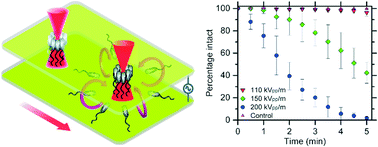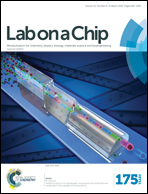Trapping and viability of swimming bacteria in an optoelectric trap†
Abstract
Non-contact manipulation methods capable of trapping and transporting swimming bacteria can significantly aid in chemotaxis studies. However, high swimming speed makes the trapping of these organisms an inherently challenging task. We demonstrate that an optoelectric technique, rapid electrokinetic patterning (REP), can effectively trap and manipulate Enterobacter aerogenes bacteria swimming at velocities greater than 20 μm s−1. REP uses electro-orientation, laser-induced AC electrothermal flow, and particle–electrode interactions for capturing these cells. In contrast to trapping non-swimming bacteria and inert microspheres, we observe that electro-orientation is critical to the trapping of the swimming cells, since unaligned bacteria can swim faster than the radially inward electrothermal flow and escape the trap. By assessing the cell membrane integrity, we study the effect of REP trapping conditions, including optical radiation, laser-induced heating, and the electric field on cell viability. When applied individually, the optical radiation and laser-induced heating have negligible effect on cells. At the standard REP trapping conditions fewer than 2% of cells have a compromised membrane after four minutes. To our knowledge this is the first study detailing the effect of REP trapping on cell viability. The presented results provide a clear guideline on selecting suitable REP parameters for trapping living bacteria.


 Please wait while we load your content...
Please wait while we load your content...